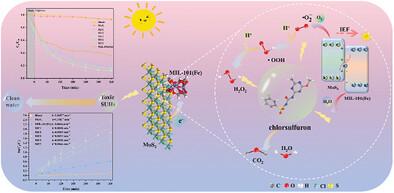Enhanced Photocatalytic Degradation of Chlorsulfuron by MoS2/MIL101(Fe) S-Scheme Heterojunction: A Conversion Mechanism Dominated by Electrons and Long-Lifetime Reactive Species
IF 13
2区 材料科学
Q1 CHEMISTRY, MULTIDISCIPLINARY
引用次数: 0
Abstract
Altering the generation route of reactive species is a potent means to augment the photocatalytic activity. In this study, MoS2/MIL-101(Fe) S-scheme heterojunction (MF2) is prepared using a water/solvent thermal method for photocatalytic degradation of chlorsulfuron. Driven by the internal electric field, the local electron density of MF2 is redistributed, thus enhancing the adsorption of O2. This promoted charge transfer to generate e−, •, and H2O2 for efficient oxidation of chlorsulfuron. It is confirmed that photogenerated electrons and long-lifetime reactive species (• and H2O2) played a major role. The degradation activity of MF2 for chlorsulfuron is much higher than MoS2 (42.21 times) and MIL-101(Fe) (4.06 times). The charge transfer mechanism of the MF2 S-scheme heterojunction is verified by experimental studies and Density Functional Theory simulation calculations. In addition, MF2 exhibited great potential for practical applications. This work provided new insights into the construction of S-scheme heterojunctions and long-lifetime reactive species-dominated conversion mechanisms.

改变活性物种的生成途径是提高光催化活性的有效手段。本研究采用水/溶剂热法制备了 MoS2/MIL-101(Fe)S-scheme异质结(MF2),用于光催化降解氯磺隆。在内部电场的驱动下,MF2 的局部电子密度重新分布,从而增强了对 O2 的吸附。这促进了电荷转移,生成 e-、-O2-$\{mathrm{O}}_{mathrm{2}}^ - $ 和 H2O2,从而高效氧化氯磺隆。研究证实,光生电子和长寿命活性物种(-O2-$\{mathrm{O}}_{\mathrm{2}}^ - $ 和 H2O2)发挥了主要作用。MF2 对氯磺隆的降解活性远高于 MoS2(42.21 倍)和 MIL-101(Fe)(4.06 倍)。实验研究和密度泛函理论模拟计算验证了 MF2 S 型异质结的电荷转移机制。此外,MF2 在实际应用中表现出巨大的潜力。这项工作为 S 型异质结的构建和长寿命活性物种主导的转换机制提供了新的见解。
本文章由计算机程序翻译,如有差异,请以英文原文为准。
求助全文
约1分钟内获得全文
求助全文
来源期刊

Small
工程技术-材料科学:综合
CiteScore
17.70
自引率
3.80%
发文量
1830
审稿时长
2.1 months
期刊介绍:
Small serves as an exceptional platform for both experimental and theoretical studies in fundamental and applied interdisciplinary research at the nano- and microscale. The journal offers a compelling mix of peer-reviewed Research Articles, Reviews, Perspectives, and Comments.
With a remarkable 2022 Journal Impact Factor of 13.3 (Journal Citation Reports from Clarivate Analytics, 2023), Small remains among the top multidisciplinary journals, covering a wide range of topics at the interface of materials science, chemistry, physics, engineering, medicine, and biology.
Small's readership includes biochemists, biologists, biomedical scientists, chemists, engineers, information technologists, materials scientists, physicists, and theoreticians alike.
 求助内容:
求助内容: 应助结果提醒方式:
应助结果提醒方式:


